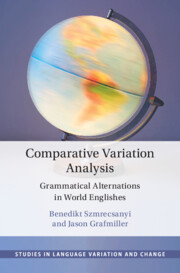Book contents
- Frontmatter
- Dedication
- Contents
- List of Figures
- List of Tables
- Series Editor’s Preface
- Acknowledgments
- Data Availability Statement
- 1 Introduction
- 2 Grammatical and Syntactic Variation
- 3 World Englishes and Dialect Typology
- 4 The Data
- 5 Alternation-by-Alternation Analysis
- 6 Distances, Similarities, and Coherence
- 7 Experimental Corroboration
- 8 Where Are We Now, and Where to Next?
- References
- Index
5 - Alternation-by-Alternation Analysis
Published online by Cambridge University Press: 24 August 2023
- Frontmatter
- Dedication
- Contents
- List of Figures
- List of Tables
- Series Editor’s Preface
- Acknowledgments
- Data Availability Statement
- 1 Introduction
- 2 Grammatical and Syntactic Variation
- 3 World Englishes and Dialect Typology
- 4 The Data
- 5 Alternation-by-Alternation Analysis
- 6 Distances, Similarities, and Coherence
- 7 Experimental Corroboration
- 8 Where Are We Now, and Where to Next?
- References
- Index
Summary
This chapter interrogates corpus data to analyze the three alternations subject to study in this book one by one using a battery of state-of-the-art analysis techniques in addition to customary descriptive statistics, Conditional Random Forest (CRF) modeling and mixed-effects logistic regression analysis. The goal of the chapter is to uncover qualitative generalizations: for example, we see that while effect directions of constraints on variation are generally stable across varieties of English, effects strengths can be significantly different.
Keywords
- Type
- Chapter
- Information
- Comparative Variation AnalysisGrammatical Alternations in World Englishes, pp. 82 - 111Publisher: Cambridge University PressPrint publication year: 2023

